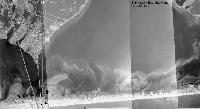 |
June 30, 1938. This photograph was
taken before the Great New England Hurricane of 21 September 1938 cut
Shinnecock Inlet. During the storm, the barrier breached where a channel
crossed from the bay to the road. Another identifier of the future inlet's
location is the left-right jog in the road, which disappeared when the storm
washed away this part of the barrier. The channel may be a remnant of an inlet
that was dug by the Shinnecock and Peconic Canal Company in 1896. This image is
part of a mosaic prepared by the Beach Erosion Board, the predecessor
organization of the U.S. Army Corps of Engineers' Coastal Engineering Research
Center. |
 |
September 24, 1938. Taken 3 days after
the Great New England Hurricane, this image shows the new Shinnecock Inlet and
many overwash fans along the adjacent shore. These fans and inlets attest to
the tremendous power of this storm, the most devastating hurricane on record to
strike the Northeast coast of the United States. All the inlets along this
stretch of the coast trended left of shore-perpendicular. The overwash fans
demonstrate a mechanism by which sand is carried from the open coast into the
back bays. This image is part of a mosaic prepared by the Beach Erosion Board,
a series of 157 photographs covering Fire Island Inlet to Southampton. The
photographs were probably taken by the U.S. Army Air Corps, Mitchell Field,
Long Island. |
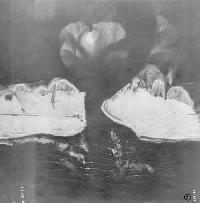 |
February 24, 1939. Five months after
the hurricane, a prominent flood shoal has formed in Shinnecock Bay, but only a
small ebb had grown on the Atlantic side of the inlet, Construction equipment
is stockpiled on the road just west of the inlet. Suffolk County, with support
from the Works Progress Administration, constructed a 1,470-ft bulkhead along
the west side of the inlet. The ocean shore east of the inlet remained
unstructured. This image is part of a photographic mosaic prepared by the Beach
Erosion Board. |
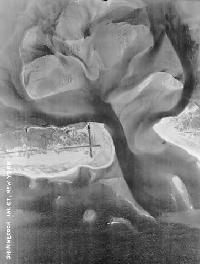 |
April 1, 1947. Seven years after the
1938 hurricane, the flood shoal has grown dramatically. The main channel
through the inlet had migrated away from the west shore revetment and extends
out to sea in a NW-SE direction. Two channels formerly circled the flood shoal,
but at this date, the east channel has shoaled next to the east shoreline of
the inlet. The main channel now turns west and follows the bay shoreline to the
west. A spit has grown out from the west shore, and a sand bar is located in
the mouth of the inlet. |
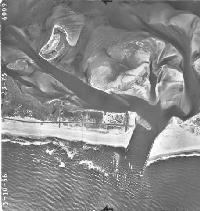 |
March 10, 1956. The east and west
jetties have been completed, and now the channel is restricted to a N-S
direction. A sand spit still protrudes from the west beach into the inlet. The
updrift fillet (on the east (right) side has begun to fill with sand. Note that
the west beach is straight because the area directly west of the west jetty had
not yet begun to erode. The dune that parallels the road is vegetated almost to
the edge of the inlet. In the future, this area would suffer chronic erosion.
(Photograph by Lockwood, Kessler & Bartlett.) |
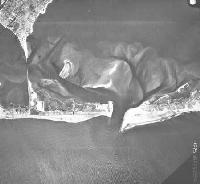 |
March 25, 1962. This photograph was
taken two weeks after the Ash Wednesday northeaster of 6-8 March. Although this
storm caused extensive beach erosion and property destruction throughout the
Atlantic seaboard, the area near Shinnecock Inlet appears to have suffered no
morphologic changes. The indentation in the shoreline just west of the west
jetty shows the erosion-prone area. The bulge on the west beach where the ebb
shoal attaches to the shore is about half-way between the inlet and the
Ponquogue Bridge. Over the following 35 years, as the ebb shoal grows, the
bulge will migrate west until it is approximately adjacent to the bridge.
(Photograph by Lockwood, Kessler & Bartlett.) |
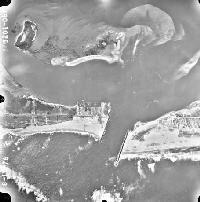 |
August 10, 1976. This photograph was
taken one day after Hurricane Belle crossed the area. The west beach is flush
with the end of the west jetty because of beach fill. Compared to 1962, the
lobes and bars of the flood shoal have grown and moved further north into
Shinnecock Bay. The ebb shoal has also grown. Four black lines crossing the
west beach appear to be drawn with a fine pen on the photographic paper print.
(Photograph by AeroGraphic Corp.) |
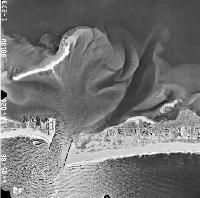 |
April 5, 1988. Waves can be seen
entering the inlet and diffracting in a circular pattern in Shinnecock Bay. An
exposed sand bar in the flood shoal, previously straight or V-shaped, now
resembles a "T" with the growth of a spit southeast toward the inlet.
West of the west jetty, unvegetated beach sand extends up to the road. In the
1962 photograph, this area still had a vegetated dune. (Photograph by
AeroGraphic Corp.) |
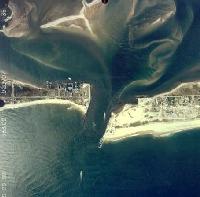 |
September 29, 1992. In this image, the
east beach has advanced almost to the end of the east jetty, while the west
beach has receded severely. Part of the west beach is less than 20-30 m-wide.
The east revetment within the inlet has deteriorated, accompanied with erosion
of east shore. Jetty repair has begun, and a barge containing rock is moored in
the east channel in Shinnecock Bay. In the flood shoal, the exposed T-shaped
sand bar has moved and changed shape. (Photograph by TopoMetrics, Inc.) |
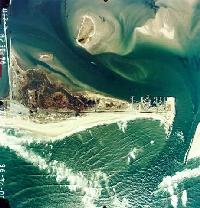 |
October 24,1996. Breaking waves show
where the west edge of the ebb shoal joins the west beach. The ebb shoal is
still approximately a symmetric oval of sand, but compared to the 1960's and
1970's, it has been pushed about 500 m west of the inlet mouth. Rough water can
be seen between the jetties and across the mouth of the inlet. With the wave
conditions on this day, a boat leaving the inlet would encounter breaking waves
on the forward port quarter. (Photograph by Sidney B. Bowne & Son.) |
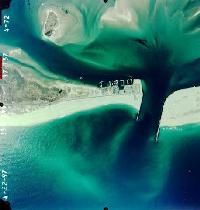 |
April 22, 1997. The edge of the ebb
shoal is clearly visible in this image, taken on a day with almost no waves and
clear water. Water depth at the bar is about 3 m (10 ft). The dark water off
the mouth of the inlet is the deposition basin. Both the ridge of sand that
projects seaward from the west jetty and the deep hole to its west were
measured by bathymetric surveys in the 1990's. (Photograph by Sidney B. Bowne
& Son.) |
 |
October 10, 1999.Geomorphically, the
inlet, beaches, and flood shoal have not changed greatly in two and a half
years since the previous photograph was taken. In 1998, 440,000 cu. yd. of
material were dredged from the entrance channel and the deposition basin and
placed on the beach west of the inlet, in a zone between the jetty and 3,500 ft
west. The sand was placed as a berm between the dune line and the water. This
feature cannot be seen in this photograph because of scale and file size
constraints. |













